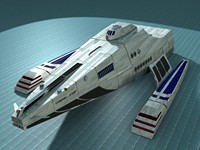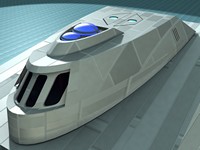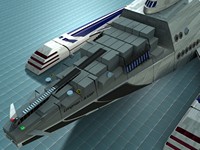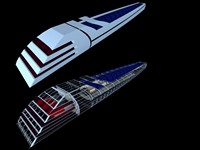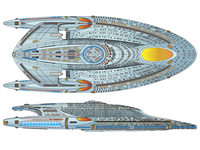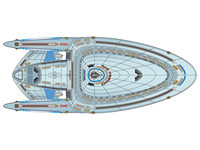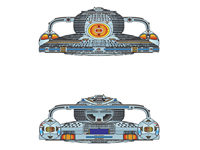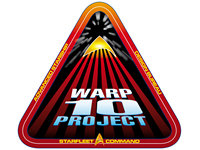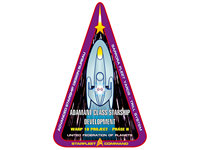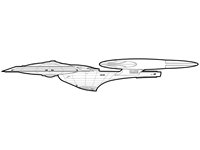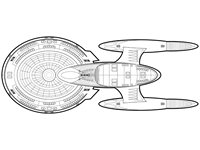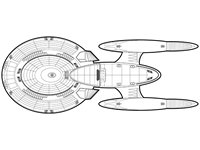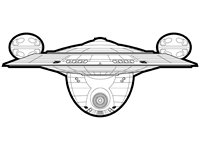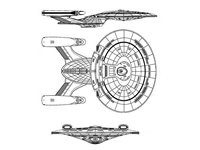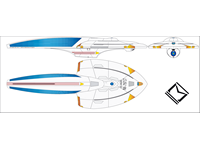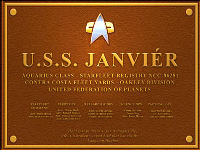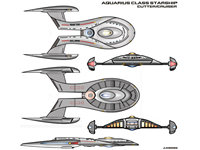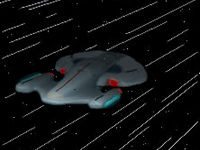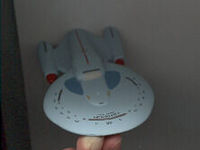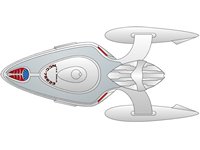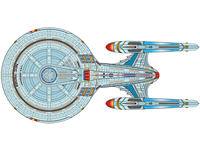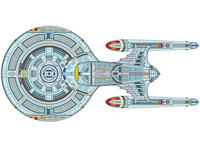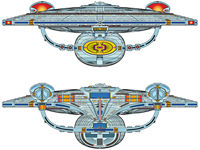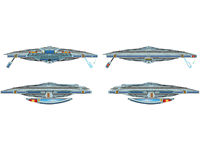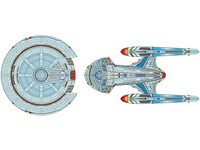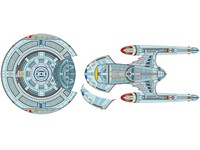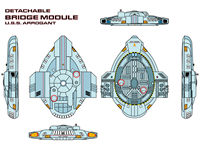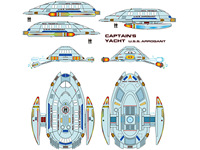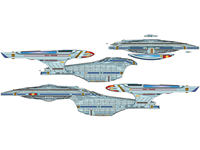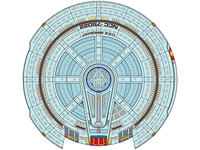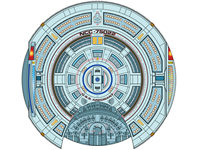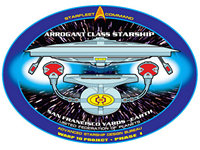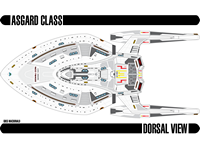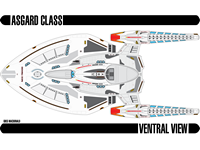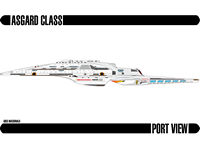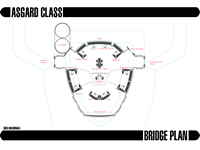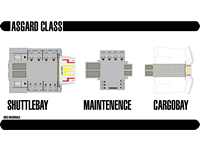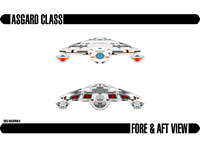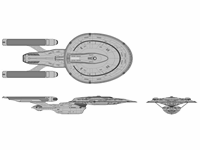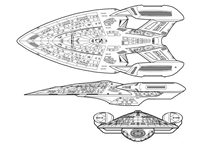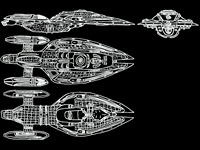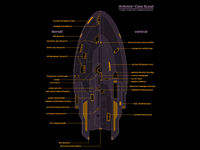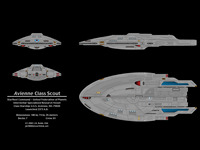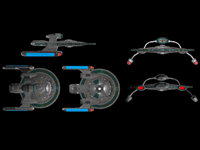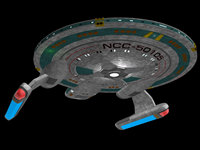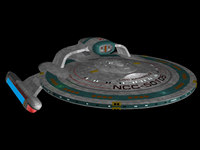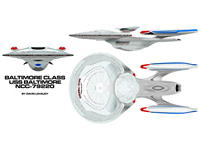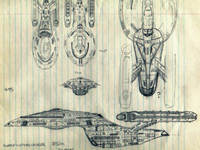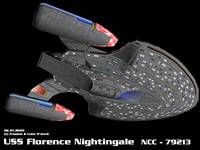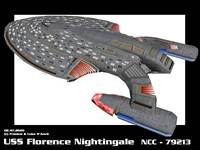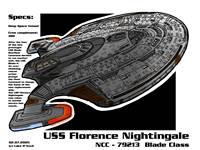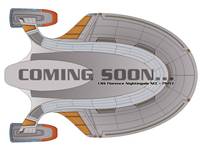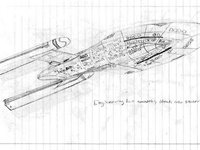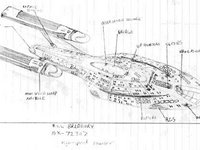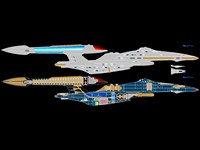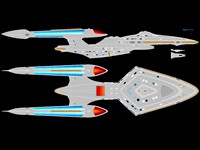Starships A-B
Starships, Starships A-B, C-E, F-H, I-L, M-N, O-Q, R-S, T-Z, Space Stations
Abstraho Class
Design by Pleiades (David)
Type: Freighter
First commissioned: 2379
Length: 136m
Width: 83m
Height: 32m
Decks: 7
Complement: 5 officers + 15 crew, evacuation limit: 30
Speed: Warp 5.20 (cruise), Warp 9.76 (max.), Warp 9.80 (max. emergency)
Armament: 2 forward Photon Torpedo launchers, 6 Phaser turrets
Defense: AS100F shielding, dual layer tritanium armour, prototype thin layer tritanium armour
Embarked craft: 8 Workbee drone micro transporters
Volumetric cargo limit: 6000m3
Approx. container limit: 120 boxes (boxes 7.5 meters long, 2 meters high and 3.2 meters wide)
Ships
- Abstraho
- Longman
- Sarakarn
- Paladin
History
The Abstraho class is the latest in Federation transport technology, based off cargo places such as an Antonov and the Beluga aircraft of the 20th and 21st century aircraft manufacturers. The idea was to be able to deliver huge amounts of cargo in one go, enough to establish a medium base. The craft has specially designed Workbees that are able to lift boxes 7.5 meters long, 2 meters high and 3.2 meters wide. The craft is able to store approximately 120 boxes that are of this size. This means that the volumetric storage of this ship in box size is 5760m3, a very large capacity. The Abstraho was designed as a bulk carrier of goods, with its large front hold it is able to offload slightly faster than most other transports of her time. The freighter is able to carry an almost infinite complex of loads, it has a controlled environment system that can keep goods near -273.15°C and over 500°C as standard, This called for insulation for the crew, so that this immense difference in temperature is not felt throughout the ship, the simple solution was a vacuum bulkhead that wraps right the way around the cargo area, this old but simple system was enough to pass tests in its prototype years.
The Abstraho's main feature is the Envirolite System; this is a highly specialised system and is a new system used exclusively on this ship class, this allows the ship to absorb the environment around it, so that substances and life forms can travel in comfort, this can flood the cargo bay area in around 2-5 minutes, the tanks on the side allow the environment to also be stored, these tanks are hyper compressed to get maximum storage in them. These tanks allow the slow release of the environment sample collected from the surrounding air on a planet. The system means that no human contact with the system is needed. The supply feed is a large quad vent shaped to the ship on the nose of the craft, this vent protrudes enough to allow a quick fill however are small enough to be regulated. The vents are two ways and can offload the environment as it can on load it, but this calls for a specialised dual force field system to prevent rapid decompression in the event of failure, this force field dual system will activate as soon as the fill or offload is finished, this relies on its own power system, to try and make the most safe effect, in case of failure of that power system, there is also a physical plate that can cover the vents in 20 seconds. The system can also be used to keep the pressure stable, releasing and taking in hyper compressed 'environment' from the tanks.
Overall the Abstraho is top of the range when it comes to doing its intended work; it is able to be adapted for thousands of possible circumstances, while providing a practical, fast and large transport solution all in one package. It is able to sustain a speed that comes close to that of the top performers in the Federation. Its specially designed nacelles allow it to land on a planet without the need for extra landing legs, because they provide a perfect balance and low centre of gravity. Meanwhile the ship is capable of defending itself, they need little much in the form of a crew, and the ship can provide power for very long journeys across the Alpha and Gamma quadrant. Starfleet's aim for this class of ship, is to give many ensigns and graduates a first posting, and more opportunity of learning about new places, exploration and while doing this, still being able to do given tasks to them. The smaller crew means that new people will gain the attention they need, while the ship can fully support itself once it is operational. Onboard there is 1 smaller holodeck, where the crew can relax, simulate training missions, train ensigns and graduates and chart the galaxy as they go.
Another point that was made in a final 'Prototype of the family' journal by the Utopia Planitia shipyard engineers is that "The Abstraho class isn't just about transport, hauling heavy goods and VIPs across the galaxy, it is a ship that is made for community amongst officers, it is made for exploration, but at the same time can do its primary job, transport..." (Chief Engineer Simon Taylor)
Adamant Class (2)
Design by Gustavo Castillo
Type: Explorer
First commissioned: Stardate 57125.3
Length: 617m
Width: 243m
Height: 99.7m
Decks: 28
Complement: 173 officers + 524 crew, evacuation limit: 9500
Speed: Warp 7.5 (cruise), Warp 9.2 (max.), Warp 9.989 (max. emergency)
Sublight speed: 0.65c (max.)
Armament: 13 standard phaser banks, 2 phaser pulse cannons, 2 front torpedo launchers, 1 aft torpedo launchers
Defense: metaphasic shields
Embarked craft: 7 type 22 shuttlecraft, 4 type 31 cargo shuttle (inc. 1 MedAway), 6 workpods sphinx type
Warp 10 Project, Phase 2. As part of Starfleet program to attain Warp 10 speed, which began with the U.S.S Arrogant, here's the second stage: the U.S.S. Adamant. [Note from the editor: Not to be confused with the unattainable Warp 10 speed of conventional warp drive designs.] The idea of separated warp cores, one for each nacelle, is almost as old as warp propulsion itself, since the process of dividing in two the plasma stream, resulting from the matter-antimatter reaction, implies a significant loss of propulsion energy. The theory states that, if that loss could be avoided by means of individual cores powering only one nacelle, performance would be optimized and warp speed increased geometrically. The problem was the impossibility of matching the frequencies of the warp fields generated by each core.
Trill scientist Dr. Jolenk Brall, assisted by his son, Lt. Commander Rolenk Fen, developed a revolutionary "Core Synchronizer". Dilithium crystals produce a singular vibration when attacked by the matter and antimatter streams, unique for each crystal element, which determines the frequency of the warp field's wave. Wrapping a subspace field around the two crystals (one per core), thus isolating them both in the same space-time continuum, allows the "Synchronizer" to control and equalize the vibrations, allowing the formation of two identical plasma currents, so the warp fields produced by each nacelle are a perfect match. To achieve its difficult task, which allows NOT the smallest deviation, the "Synchronizer" has its own dedicated computer core. This solution, as simple as it seems, required 90 years of development. It was an original idea of Dr. Lerek, from Vulcan, and Dr. Adsor Brall, from Trill (Adsor being the previous host of the symbiont Brall), at Daystrom Institute.
At first the vessel design considered to carry this new, experimental propulsion system, was to be a smaller one, perhaps the size of the Intrepid class or even a Nova class starship, but preliminary tests showed that a warp coil less than 150 meters long would not provide enough runway length to be able to process the energy levels of the new, more powerful, plasma stream, nor tolerate the stress without fractures or even exploding. So, the bigger the nacelles, the bigger the ship: The U.S.S. Adamant is a 600m long starships, with all the commodities, amenities and services of a Galaxy class starship. In theory, the goal of the experiment was to reach warp speed factor 9.999... In the field, the Adamant reached and sustained continuously Warp 9.989999 for 8 hours. It was, however, considered a success, and makes the U.S.S. Adamant the fastest starship of the Federation to date. Lt. Commander Rolenk Fen serves on board the Adamant as Chief Engineer to look after the first steps of his father's "brainchild", to continue with the tests (the Adamant is still in her experimental stage), and to satisfy his need to explore the galaxy.
Note: Starfleet Command commissioned a team of engineers to adapt the "Core Synchronizer" to the Arrogant class starships. But there is little hope for it to be feasible, since the cores are of very different power levels and located in two separated and very distant parts of the ship (one in the primary, the other in the secondary hull) Admiral Rosen, the eldest Terran admiral still in service at Starfleet Command made a comment about the shape of the Adamant, saying that it resembles an old "iron", an ancient tool to press clothes. He joked: "This starship is here to smooth the fabric of space."
No one understood the joke.
Log in to protected area with user="guest" and password=<Riker's middle name> to download detailed PDFs of this design.
Annapolis Class
Design by Michael Giallombardo
Type: Heavy cruiser
First commissioned: 2382
Length: 665m
Width: 260m
Height: 103m
Decks: 26
Displacement: 4,425,000t
Complement: 150 officers + 700 crew, evacuation limit: 10000
Speed: Warp 8.925 (cruise), Warp 9.7 (max.), Warp 9.75 (max. emergency)
Sublight speed: 0.7c (max.)
Armament: 4 type-XIV phaser arrays; 6 rapid fire torpedo tubes
Defense: 8 6.5 GW exterior shields; 6 3.7 GW interior shields
Embarked craft: 3 type 1
The Annapolis-class starship was the vision of young Admiral William A. McGarvey. With recent threats against the Federation in the last several years, McGarvey insisted that this new class of starship be the bridge that gaps the capabilities of battle-worthiness and exploration.
This ship has been rendered in RHINO 3D and has been exported to the PC game Bridge Commander.
Andromeda Class
Design by Mackenzie
No specs available
This is an alternative design for the Andromeda class being developed at the ASDB.
Anzac Class
Design by Voron
Type: Exploratory cruiser
First commissioned: 2383
Length: 390m
Width: 120m
Decks: 9
Complement: 100 officers + 30 crew, evacuation limit: 200
Speed: Warp 9.4 (cruise), Warp 9.7 (max.), Warp 9.9 (max. emergency)
Armament: 7 Type XI Phasers, 1 torpedo turret and one aft torpedo tube
Defense: Standard shield system, ablative armour
Embarked craft: 2 type 18 shuttle pods, 2 type 20 shuttles, 1 Delta Flyer class runabout
Development goals
- To replace ageing defence orientated vessels with modern replacements that are more versatile
- To create a flexible forces of ships designed for multi-tasking
- To supplement Explorer, surveyor and science vessels
- To replace ageing Miranda, Oberth and Excelsior as the Primary exploration ships.
History
The Anzac class project was launched with little fanfare two weeks after the completion of the Galaxy class project in 2362. The intention of the project was twofold. One, to design a advanced explorer that was smaller and more economical to operate than a Galaxy and two, a ship whose combat abilities are enhanced due to new advances that are to incorporated in to Sovereign and Defiant class then under construction.
The project ticked along for many years with very little in the way of progress it was estimated that the in service time would be around 2385-2390 as there was little need for what even the designers themselves considered a Galaxy stablemate. That changed all of a sudden when the Borg threat emerged all combat ship projects received a shot in the arm. Seven projects where selected to be the first bunch of combat ships. These designs where the ones that had the most likely chance of being completed with little trouble. The Anzac began accelerated construction at the main fleet yards along side the Sovereign in 2368. As more threats to the Federation emerged the design was modified with increased weapons and also increased defensive systems due to the war with the Dominion and the Klingons. Unfortunately due to the war small ships became the main priority for the fleet the Anzac Class was postponed until more resources could be acquired.
As the restrictions of war eased and an uneasy peace settled over the quadrant the designers began to fit the ship as intended in the original design. To achieve this, the number of torpedoes was reduced to 260, split over the two armouries.
For scientific duties the Anzac class uses the brand new 5th generation sensor suite and the Holographic Science and Command Centre which has seen a lot of success in its deployment among the fleet since its birth in the Titan and Ajax class vessels. The new 5th generation sensor systems include further ability to scan on multiple resolutions with over four thousand channels being processed at once during scans and a cycle of less than a tenth of a second per sensor scan. The data from these sensors are fed to one of the four science labs or stellar cartography labs.
Aquarius Class
Design by Capt. Proton
Type: Border cutter / cruiser
Length: 283.5m
Height: 27.5m
Decks: 7
Crew complement: 70
Warp speed: Warp 9.8 (max. cruise), Warp 9.998 (max.)
Propulsion: 2 impulse engines, 2 warp nacelles, E-Z-Eject warp core design
Armament: 4 dorsal phaser arrays, 3 ventral phaser arrays, 1 forward firing photon/quantum torpedo launcher, 1 aft quantum/photon torpedo launcher.
Commissioned vessels:
- USS Aquarius NX-86280 - experimental prototype
- USS Janvier NCC-86281 - border patrol
- USS Février NCC-86282 - exploratory cruiser
- USS Soleil NCC-86283 - exploratory cruiser
- USS Etoiles NCC-86284 - border survey
The Aquarius-class vessel is a bi-purpose ship that can be put into regular exploratory service or can serve as a patrol cutter along the various borders of the Federation, specifically the Neutral Zone. The quick and maneuverable nature of the design makes it the perfect vessel for chasing down illegal transports or bandit vessels. When Starfleet finally phased out and decommissioned the Miranda and Excelsior classes after nearly 100 years of service, the Aquarius was developed to fill the place of both. Simple modifications to one variation can ready it for the other, such as adding a larger brig compliment to accommodate criminals for transport, or additional sensor placements for enhanced exploration capabilities.
Argosy Class
Design by Jason, ASDB Member
No specs available
The Argosy is a Renaissance-style starship, but considerably newer, or a possible Renaissance refit.
Argus Class
Original design by Chris, ASDB Member
Refinements by Jonahand Jason, ASDB Members
Drawing by Kris, ASDB Member
No specs available
No description
Arrogant Class
Design by Gustavo Castillo
Type: Heavy cruiser
First commissioned: Stardate 54890.7
Length: 800m
Width: 388m
Height: 131m
Decks: 36
Complement: 236 officers + 627 crew, evacuation limit: 12000
Speed: Warp 8.5 (cruise), Warp 9.3 (max.), Warp 9.75 (max. emergency)
Sublight speed: 0.65c (max.)
Armament: 19 ribbon-like phaser banks; 5 torpedo launchers; 4 pulse phaser cannons
Defense: Metaphasic bubble-like deflector shield emitted by hull grids
Embarked craft: 12 type-22 personnel shuttles; 1 Danube-class runabout; 6 type-31 cargo shuttles (incl. 1 MedAway); 7 type-14 short range shuttlepods; 5 Sphinx-type workpods; 5 general purpose crafts
A design aimed to provide warp capability to the primary hull when separated. This will give the ship many tactical (multi-vector assault) as well as practical advantages (the starship can go to two destinations at warp speed simultaneously). The idea, as simple as elegant, was inspired by the variable geometry nacelles of the Intrepid class: to place two "drop down" nacelles below the primary hull that descent to warp position when the saucer separates from the engineering section. When not in use, they return to their resting position, becoming one with the main hull. To generate warp propulsion the saucer needed its own warp core and engineering room, located at the lower side of the saucer section. Among other improvements, the fire power was increased due to 4 phaser pulse cannons placed on the nacelles pylons. Another addition is the metaphasic shielding, which allows a greater energy dispersion.
After a year and a half of exhaustive tests and trials the prototype successfully passed her experimental phase, the saucer section reached and effortlessly sustained Warp 6, as planned, so it was determined that the registry changed from NX to NCC and the model went into standard production. By Stardate 56049.2 Starfleet had already commissioned 4 more Arrogant-Class vessels: U.S.S. Takakura, U.S.S. Starbuck, U.S.S. Kranegh and U.S.S. T'Mer.
Note: it has been theorized that this ship may reach Warp 10 if both warp cores, saucer and engineering, work together when the hulls are attached.
[Note from the editor: Not to be confused with the unattainable Warp 10 speed of conventional warp drive designs.] Due to the present impossibility of matching the frequencies of the warp fields generated by each core, this theory has not yet been proven. However, the Advanced Starship Design Bureau decided to continue the research in order to develop this possibility, would it be on this class as well as future starship designs to reach the ultimate speed, calling the endeavour Warp 10 Project, the Arrogant class being the first step, or Phase 1. The motto on the Arrogant's bridge dedication plaque reads: "Wherever you are today, it's just the beginning of the journey".
Log in to protected area with user="guest" and password=<Riker's middle name> to download detailed PDFs of this design.
Asgard Class
Design by Greg MacDonald
Type: Tactical cruiser
First commissioned: 2374
Length: 428m
Width: 190m
Height: 57m
Decks: 14
Displacement: 1100000t
Complement: 50 officers + 200 crew, evacuation limit: 2000
Speed: Warp 8 (cruise), Warp 9.9 (max.), Warp 9.95 (max. emergency)
Sublight speed: 0.25c (max.)
Armament: 2 type-XII phaser cannon, 14 type-XII phaser arrays, 4 pulse-fire quantum torpedo tubes + 448 torpedoes
Defense: Regenerative shield system, ablative armour plating, SIF plating
Embarked craft: 2 Argo class cargo shuttlecraft, 8 Type 11 shuttlecraft, 6 Type 9 shuttlecraft, 6 Type 8 shuttlecraft, 7 Workbees
Unit run: 3 vessels total
- U.S.S. Asgard NCC-78400
- U.S.S. Midgard NCC-79101
- U.S.S. Vanaheim NCC-79102
After the Borg attack in 2367 and the devastating losses taken in the Battle of Wolf 359, Starfleet found itself at a tactical and technological disadvantage to a foe for the first time in over a century. Starfleet had become complacent on matters of defense, content only to keep pace with the Klingons during the extended period of peacetime.
Starfleet Command ordered the immediate development of three new heavy, medium and light starship designs with a focus on tactical operations. The existing Sovereign design program, originally intended as an eventual Galaxy successor, was retasked for the heavy role. This dramatically cut down on the design time a ship of that size would normally take, and along with an accelerated development program allowed the first ships of the class to be launched in 2371 and commissioned a year later.
The light ship design became the Defiant program at Utopia Planitia and proceeded at an unusually rapid pace, with construction on the prototype vessel completed by 2368. This quick design process resulted in a number of flaws and ultimately the Defiant program was mothballed for a number of years.
The medium starship design brief was assigned to the Beta Antares yards. They decided to produce two designs in parallel, hoping that the competition between the two teams would result in a stronger final design. Unlike the heavy and light designs, both teams, eventually designated Asgard and Prometheus, would be starting from scratch with a projected development duration of seven years.
The design brief called for a ship in the 400m range, capable of warp 9.9 maximum cruise speed, capital ship level armament and the ability to operate at extended ranges.
Work progressed without incident over the next 7 years, unaffected by the (temporary) cancellation of the Defiant program. On schedule, both teams submitted a design for construction and the two prototype vessels were launched in early 2374. Both ships shared characteristics such as Type XII phaser arrays, bio-neural gel packs, ablative armour and a regenerative shielding system.
Of the two designs, Asgard was the more traditional. A pair of low slung warp nacelles and wide saucer gave it a surprising degree of agility, while two pairs of impulse engines allowed impressive combat acceleration and large power reserves. The ship had notable firepower for her size, with 14 phaser arrays and 4 torpedo tubes, 2 fore/2 aft with a large supply of quantum torpedoes. A unique feature of the Asgard was 2 phaser cannons were built directly into the hull, flanking the deflector dish. This allowed a powerful armament for both alpha strikes and sustained fire against stationary targets.
Passive defensive measures included a mix of ablative armour over the entire ship and SIF reinforcement plating over key areas. Electronic defense was provided by a state of the art regenerative shield array, initially developed for the Sovereign. This in turn was supplemented by a system allowing the computer to automatically reroute reserve power from the saucer impulse engines. When incoming enemy fire was detected, this power would be used to instantly reinforce the affected shield arc.
However, the Prometheus that made the greater impression, with her innovative multi-vector assault mode and extensive automation. Going into trials, Prometheus was the initial favourite.
This began to change as the trials progressed. Prometheus was cramped and restricted in internal space, as a result of the considerable internal space taken up by the complex MVAM. The space constriction on supplies and fuel led to a maximum 10-month deployment.
By contrast, the Asgard's conventional design offered extensive internal space, letting her carry standard-sized crew quarters. As well, her recreational facilities rivaled the Intrepid class, even including two holodecks. Her extensive cargo bays allowed for a 4-year deployment. Her shuttlebay was her most impressive feature: a cavernous space almost six times the size of the Prometheus bay, with hangar and maintenance bays to match.
However, Prometheus was not yet beaten. Her armament was a match to the Asgard, with comparable defenses, although murmurs about what would happen if the middle hull were destroyed in combat were a concern. However, Prometheus still had one surprise left.
When warp trials began, Asgard, after some minor adjustments, reached her maximum cruising speed of warp 9.9 on her third full power run. This matched the Sovereign class in warp capabilities, with just a slightly shorter maximum warp speed duration of 9.95 for 20 hours vs. 36 hours for Sovereign. While this technically made the Asgard the third fastest class in Starfleet, it was quickly overshadowed when the Prometheus began her tests. At the start of her first full power run, she matched the Intrepid class U.S.S. Wanderer shadowing the run by pushing straight to warp 9.975. She then carried on to her own maximum cruise speed of 9.985, a figure the Wanderer could only match for an hour. Prometheus then completed her amazing performance by managing to hit 9.99, although it was estimated she could only hold that for an hour or two at most.
Thanks to her stellar warp speed performance, Prometheus' standing rose considerably in the competition, with the two designs considered about equal.
This all changed four months into the evaluations when the Prometheus, on long range warp trials, was captured by Romulan agents, who attempted to fly the ship into Romulan space. Thankfully, the advanced prototype was narrowly recaptured, but the event caused a great deal of consternation to Starfleet Command. Outside of the obvious security implications over a Starfleet vessel being attacked and captured by a supposed ally, there was the possibility that detailed information about the Prometheus had been obtained by the Romulans during the attempt theft. The thought that the Romulans could have the full design specifications of one of Starfleet's most advanced warship nearly caused the outright cancellation of the Prometheus' development. The surviving team leads of the Prometheus team desperately argued against the cancellation of the project, an argument that seemed hopeless when two more Asgard prototypes were ordered in advance of the expected end of the trials.
This changed three months later when the final report on in the Prometheus incident came back. Detailed analysis of the ship's automated logs and records showed that no information about the Prometheus had been transmitted to Romulan hands. With all the members of the Romulan infiltration unit captured or killed, this meant the technical security of the Prometheus was intact and development was allowed to continue. Despite this, the triumph of the Asgard seemed assured, especially with the extra hulls ordered.
However, the Prometheus team was not quite down for the count. The trials plus the real-world data from the hijacking led to the Prometheus team to revisit the MVAM concept. While the ship had a 15.6% increase in tactical efficiency when separated, this was counter-balanced by a 22.3% decrease in shield capacity and an astounding 42.7% decrease in structural integrity on the vital secondary hull.
This led the team to reintroduce an earlier version without MVAM, but with numerous tweaks from lessons learned from the Prometheus herself. This changed the internal structure of the ship considerably, allowing the ship comparable internal volume to the Intrepid. While the Asgard still retained greater internal volume, most of the excess was spent on cargo and shuttle handling capacity. In addition, the changes to the Prometheus class simplified her warp core and power-transfer design, allowing for a more efficient version to be installed. These changes allowed the Prometheus class to go without supply for up to a now reasonable 2.5 years.
They rushed a second prototype, the Hephaestus, to production. In trials, she proved to have the same speed as her sister with only slightly degraded tactical capability. When the final decision on the competition came through, it was the redesigned Prometheus that was chosen, with her exceptional warp speed listed as the deciding factor. Prometheus herself retained the MVAM, due to the prohibitive cost of rebuilding the ship and to allow for future study of the concept. The ship was permanently transferred to the First Fleet, in defense of the Federation's Core Worlds.
The Asgard and her sisters had successfully completed their trials, so Starfleet Command saw no reason not to commission them into active service, despite losing the competition. Asgard herself was actively engaged during the final months of the Dominion War, being one of the few ships to escape intact from the Second Battle of Chin'toka and part of the Federation fleet at the Battle of Cardassia.
Thanks to Sean and Steve for their help with the history.
Atlanta Class
Design by Simon Royall
Type: Cruiser
First commissioned: 2377
Length: 600m
Width: m
Height: 110m
Decks: 30
Complement: officers + 750 crew
Speed: Warp 7 (cruise), Warp 9 (max.), Warp 9.8 (max. emergency)
Sublight speed: 0.25c (max.)
Armament: 6 Type XI phasers 3 MK I quantum torpedoes
Defense: fss type shields ablative armour over key areas
Embarked craft: 24 shuttlecraft
The Atlanta class ships were devised just prior to the dominion war but only one the Atlanta was built but was never in combat but was used to patrol the Romulan border. The other ships were built during the war but at a slow rate. Once the war was over increased fleet rebuilding was started, the Atlantas are general purpose starships jack of all trades. Their main purpose is towards exploration, indeed the first 12 are built to this end and are considered very reliable workhorses. The second batch of 12 will be more geared towards combat with a slightly heavier weapons integration
Atlantis class
Design by Dusty
Type: Explorer
First commissioned: 2380
Length: 395m
Width: 315m
Height: 237m
Decks: 15
Displacement: 4,650,000t
Complement: 75 officers + 80 crew, evacuation limit: 300
Speed: Warp 7.5 (cruise), Warp 9.9 (max.), Warp 9.975 (max. emergency)
Sublight speed: 0.8c (max.)
Armament: 5 type-XIV phaser arrays; 6 rapid fire torpedo tubes
Defense: 8 8.0 GW exterior shields; 6 5.0 GW interior shields
Embarked craft: 3 Type-11 shuttlecraft
The Atlantis-class starship was originally designed as a medium-range attack vessel made for the Dominion War. Unfortunately this class of vessel was plagued with flaws. It wasn't until Starfleet R&D researched this vessels problems and corrected them. In 2379 the first Atlantis-class starship was completed and commissioned on August 25th. Now she is in service with the Romulan Task Force along with Captain Riker's Titan.
Avenger Class (1)
Design by Matthew Keirl
No specs available
No description
Avienne class
Design by Jeff Robb
Type: Scout
First commissioned: 2373
Length: 180m
Width: 74m
Height: 25m
Decks: 7
Displacement: 251,000t
Complement: 26 officers + 55 crew
Speed: Warp 8 (cruise), Warp 9 (max.), Warp 9.2 (max. emergency)
Armament: 4 Type-VIII phaser arrays; 2 standard aft photon torpedo tubes
Defense: Standard and transatmospheric shields
Embarked craft: 4 Type-8 shuttles
Recently, several planetary exploration interest groups within the Federation (and Starfleet Command itself) found untapped advantages in a starship-size transatmospheric scout platform, and advocated the creation of one. Like the more conventional Nova, it eventually became one of several competing designs to ultimately replace the Oberth class of specialized science vessels. Once the design parameters of the Intrepid class were proved feasible, the Avienne Class Project was initiated to produce a smaller version. This "junior" vessel would also be capable of excellent interstellar and sublight performance, yet its smaller size and compact structure would enable better transatmospheric behavior and facilitate more planetary starship landings and liftoffs. However, problems with the Avienne's nacelle-to-hull shielding delayed its introduction; in the meantime, Starfleet Command decided to commission a small number of the Nova class.
Although they are close in terms of size, there is very little a Nova can do that an Avienne cannot. The Avienne's more space-efficient design is also aerodynamic, since this class was based upon the primary hull characteristics of the larger Intrepid class; also, it specializes in multiple scientific probe operations, carrying at least forty various probes. An Avienne features two inboard vertical probe/buoy launchers; if the ship is landed, it can still launch probes into orbit, or to orbit nearby moons. Two probe retrieval bays are located immediately behind the launchers, and each is equipped with a tractor beam array. Alternately, a probe can be retrieved by beaming it directly into the refurbishment area inside the retrieval bay. The scout's main tractor beam emitters are located in niches at the forward ventral hull and the aft section; the aft emitter, in fact, can pivot within a full 180-degree vertical arc. In an atypical fashion for a Starfleet vessel, the twin warp nacelles are closely connected to the main hull and rotated so that their grilles radiate vertically instead of horizontally. Though initially difficult to engineer to modern safety standards, this arrangement pays great dividends in structural stability. With an Avienne, an authorized elimination of lifeboats, the absence of standard vertical viewports, and minimal phasers upon the primary hull increases usable internal space. Baseline structural integrity is also improved, especially important for a transatmospheric starship. Larger viewports are set within rectangular recesses for observatories and crew lounges. Good floorplan management also enables a complement of four shuttlecraft (usually Type-8) instead of two, along with increased room for cargo, typically scientific and exploratory equipment.
The Avienne's landing ability ranges from alighting upon small spherical moons to penetrating deep and vast planetary caverns. Each landing pad is split in two width-wise and thus slides apart during extension in order to distribute the ship's mass more evenly at the contact zones. The main (center) landing strut assembly extends a short distance directly down and thus provides a highly stable support for the ship, whereas the struts housed just inboard of the warp engine nacelles must extend to a greater distance. Even so, the arrangement is more stable than the Intrepid's four short articulated struts, but both ships must augment the strength of their struts with counter-gravity measures. While at rest, the ship's RCS thrusters remain online to ensure its level attitude. Crewmembers can disembark via transporter, or by two stair-ramps that pivot down from the ship's ventral hull. Finally, during the liftoff procedure, the ship's "footprints" can be sufficiently "erased" by using transporters to restore the compacted soil in the contact zones. While the Avienne's enhanced landing abilities provide a new array of desirable exploratory options unavailable to other starships, the decision to land the ship must first be deemed as the best available option by its commanding officer, as the procedure for descent and ascent with a transatmospheric starship is still relatively new.
As a scout, an Avienne's armament is largely defensive in arrangement. Four short Type-VIII phaser arrays together cover the ship's entire forward hemisphere, and twin standard aft photon torpedo tubes are available to discourage pursuers. Along with its powerful "pack"-type impulse engines and resultant maneuverability, the class is biased more toward surviving or escaping damage than inflicting it. An Avienne's normal interstellar cruise speed is Warp 8 (1024c), with a maximum cruise of Warp 9 (1516c) and a maximum surge of Warp 9.2 (1649c). The nacelles are capable of sustaining greater speeds, which may be achieved in the future with compact warp cores of greater output.
Bainbridge Class
Design by Lance, ASDB Member
No specs available
No description
Baltimore Class
Design by David Lovejoy
Type: Explorer
Length: 812m
Beam: 388m
Height: 215m
Decks: 60
Mass: 8,450,000t
Crew complement: 1,720
Speed: Warp 9.915 (for 24 hrs)
No description
Bearn Class
Design by James Donovan
Type: Cruiser
Length: 350m
Decks: 24
Crew complement: 300
No description
Blade Class
Design by Luke D'Anvil
Type: Deep space explorer
First commissioned: 2385
Length: 500m
Width: 360m
Height: 84m
Decks: 20
Displacement: 3700000t
Complement: 40 officers + 440 crew, evacuation limit: 1300
Speed: Warp 9.4 (cruise), Warp 9.8 (max.), Warp 9.992 (max. emergency)
After the loss of the new prototype USS Blade to a second crystal entity Starfleet Command decided to run another unit, the USS Blade-A. An overwhelming rescue action prompt the Fleet Command to change the name of the new replacement ship. The USS Florence Nightingale was taken to normal service last month. As a relatively family-friendly ship the Blade class found friends among the Starfleet officers very fast.
Bradbury Class
Design by CJ Sitter
No specs available
This is an alternative design for the Bradbury class being developed at the ASDB.
Bulldog Class
Design by Danny Dale
Type: Warship
First commissioned: 2385
Length: 248m
Width: 110m
Height: 38m
Decks: 8
Complement: officers + 60 crew
Speed: Warp 9 (cruise), Warp 9.95 (max.), Warp 9.95 (max. emergency)
Armament: Primary: 4 small pulse phasers (equiv. to Defiant); 2 torpedo tubes (one fore, one aft; magazine capacity 60 photon torpedoes, 20 quantum torpedoes); 1 heavy pulse phaser cannon; Secondary: 7 Type 9 phaser strips
Defense: Standard shields, limited ablative armor on strategic areas
No description

